Area Contingency Planning Revitalization Initiative Program
44 Slides5.96 MB

Area Contingency Planning Revitalization Initiative Program Update August, 2017 Jonathan R. Smith National Program Manager Area Contingency Planning & Preparedness Office of Marine Environmental Response Policy (MER) United States Coast Guard-Headquarters Washington D.C. 202.372.2675 (o) 202.705.0730 (c) 1

ACP Revitalization OSC Planning Responsibilities Presentation Waypoints: 1. Area Contingency Planning refresher (fundamentals). 2. OSC responsibilities 3. The “Re-boot” initiative. 4. Designing a 21st Century ACP 5. PREP4C and exercises 6. New ACP review and approval process 7. Geographic Response Strategies 8. Key themes to remember

ACP Revitalization BLUF (Bottom Line Up Front) In an effort to address outstanding items identified in the DWH ISPR, the 2011 MER Enhancement Plan and energy expansion activities, initiatives are being undertaken to improving Area Contingency Planning functions and products. Nationwide, critical inconsistencies have been identified in the Coast Guard's execution of Subpart C of the National Contingency Plan (40CFR Section 300), "Planning and Preparedness." designed to address such shortfalls. This project is

ACP Revitalization Fundamentals Relationship of plans under the National Response System

ACP Revitalization Fundamentals Layered approach to planning and response National Contingency Plan Regional Contingency Plan Coastal Area Contingency Plan FRPOffshore FRPOnshore FRPPipeline FRPMobile (Rail and Truck) Vessel Response Plan Inland Area Contingency Plan FRPInland/ Onshore FRPPipeline FRPMobile (Rail and Truck) FRPOffshore (certain types)

ACP Revitalization Fundamentals The National Response System “food chain.”

ACP Revitalization OSC Planning Responsibilities FOSC is a fundamental authority for COTP. Must ensure COTPs consistently fulfill FOSC planning functions CG-wide. CG plug-n-play organization; NEED clear and consistent approach driven by sound policy doctrine. Need to better enforce accountability MER needs to achieve better progromatic “domain awareness.” Especially given staffing shortages CG-wide.

ACP Revitalization OSC Planning Responsibilities Planning versus Response Line of Demarcation (RCP) and Pre-designation OSC Transfer Engagement with local, state and federal NRS stakeholders Engagement with industry stakeholders CRITICAL Planning for WCDs PRIMARY purpose of ACPs. Need to be cognizant of ALL facilities (NOT just USCG regulated) ‒ ‒ ‒ ‒ Offshore drilling platforms Rail Pipeline LSF (“Long Skinny Facilities)

ACP Revitalization The “Re-boot” Area Contingency Planning old “legacy” program in need of revitalization and modernization. Energy Expansion stressors (rail, pipelines, shipping) DWH ISPR – unfinished business Lawsuits/legal vulnerabilities Increased congressional interest 2016 Assessment HQ Summit 2017 DCO Memo LANTAREA Workshop PACAREA Workshop NOW 9

ACP Revitalization Maintain firm foundation Ultimately need to protect the service long term. Back to basics – fulfill requirements under NCP. Need to maintain culture of uniformity and accountability.

ACP Revitalization “Project Management”

ACP Revitalization “Project Management” STRATEGIC GOAL 1.0 Establish Current Status of Area Contingency Planning OBJECTIVES 1.1 Define Current State of Area Contingency Planning 2.0 Achieve, Maintain ACP Quality and Consistency Nationwide IAW NCP 2.1 Create new ACP review/approval process 2.2 Create National GRP Repository utilizing NOAA ERMA Platform 2.3 Modernize ACP/create new NRT template 2.4 Develop new Endangered Species Act ( ESA) SOP/Guidance 2.5 Develop Section 106 SOP/Guidance 2.6 Identify and Develop planning assistance strategies and mechanisms 2.7 Ecological Risk Assessment (ERA) Instruction/Guidance 2.8 Address ACP "Outliers" including D9, D13 and D17 3.0 Improve Area Committee participation, functionality and accountability nationwide 3.1 Develop Area Committee guidelines for field 3.2 Establish new standardized reporting requirements 4.0 Ensure ACPs are strategically exercised and updated 4.1 Stand up new NSCC 2.0 (PREP4C) and update PREPX Guidelines accordingly 4.2 Synchronize/Coordinate PREPX matters with CPE and field 5.0 Establish MER-Area Contingency Planning COP and improve outreach 5.1 Hold MER/ACP Summit/Workshop 5.2 Create basic COP tools to assist in ACP outreach and education 6.0 Optimize Staffing and Resources 6.1 Conduct Forensic Analysis of OPA-90 billets. 6.2 Prepare Staffing Optimization Plan/Strategy

ACP Revitalization Designing a 21st Century ACP 1992: First generation USCG format promulgated via COMDTNOTE 16471 on September 30, 1992. 1997: Second generation first promulgated in the USCG Marine Safety Manual, Volume IX, Marine Environmental Protection, August 25, 1997. 2000: Third generation promulgated via COMDINST 16471.3 on August 21, 2000. 13

ACP Revitalization Designing a 21st Century ACP The current ACP construct is 16 years old and was designed prior to many significant events, laws, regulations and planning doctrine including (but not limited to): 9/11 The Maritime Transportation Security Act of 2002 Hurricane Katrina The National Response Framework Ports and Security and Accountability of Every Port Act of 2006 Salvage and marine fire fighting regulations (2008) Non-tank vessel response plan regulations (2013) Creation of DHS Creation of BSSE (and new regulations) Lessons learned from the Deepwater Horizon response New rail and pipeline regulations (Energy Renaissance) Many other incidents and events (including lawsuits) Our modern landscape places enormous responsibility on FOSCs, as such it is paramount that we synchronize planning efforts and optimize associated plans for more efficient response planning efforts. 14

ACP Revitalization Designing a 21st Century ACP NRT ACPlanning Workgroup Concept of workgroup presented to NRT in April, 2016. NRT voted to stand up new workgroup in May, 2016. First meeting July, 2016 – mission statement/goals. Second meeting August, 2016 – goals/SMART objectives. Charter/Action Plan to NRT for approval 29 September. Membership currently consists of national level reps, but will expand to field personnel once charter and admin issues finalized. 15

ACP Revitalization Designing a 21st Century ACP NRT ACPlanning Workgroup MISSION STATEMENT: “Develop NRT guidance which provides nationally consistent architecture to improve ACPs and facilitate alignment of all plans across the NRS.” 16

ACP Revitalization Designing a 21st Century ACP NRT ACPlanning Workgroup DRAFT PRIMARY GOALS: 1. Complete a baseline assessment outlining issues, gaps, or inconsistency among current ACPs. 2. Achieve national consistency while affording flexibility at the local level. 3. Promote synchronization and alignment of all plans across the NRS (e.g., Oil Spill Response Plans [OSRPs], ACPs, Regional Contingency Plans [RCPs]). 4. Develop a modern national architecture that supports tactical, accessible, and field friendly ACPs for all end users (industry and government). 5. Provide clarity on the RCP and ACP domains. 6. Ensure better alignment with other national planning frameworks (e.g., National Response Framework [NRF]). 17

ACP Revitalization Designing a 21st Century ACP NRT ACPlanning Workgroup ACP SURVEY COMING SOON! Comprised of 55 questions Target completion time is 30 minutes per respondent Will not be exclusive tool for informing workgroup product, BUT considered vital for industry feedback. 18

ACP Revitalization Designing a 21st Century ACP NRT ACPlanning Workgroup Survey at a glance 10 survey categories: 1. 2. 3. 4. 5. 6. 7. 8. 9. 10. Organization Identification Position Identification Geographic span of activity Experience / familiarity with ACPs Negatives Positives ACP Usability/practicality ACP consistency ACP improvements ACP Accessibility 19

ACP Revitalization Designing a 21st Century ACP NRT ACPlanning Workgroup Next Steps 1. Professional scrub/clean-up. 2. Online publication 3. Survey open for 30 days. 4. Will attempt to “advertise” via the federal register. 5. Baseline report 20

ACP Revitalization PREP4C Preparedness for Response Exercise Program 21

ACP Revitalization PREP4C A conglomeration of OPA-90 exercise requirements and associated policies consolidated into one guidebook. Guidelines are voluntary but are cited in regulations. These guidelines are co-owned/co-authored by four agencies. The PREP Guidelines address two exercise domains: The 2016 revision is the first in over a decade. This revision modernizes the PREP Guidelines to better align policy with the existing regulations and improve interagency consistency. The new guidelines incorporate salvage, marine fire fighting and non-tank vessel requirements. Spill countermeasure topics are better addressed, including deep well discharge scenarios. PREP 2016.1 coming soon! 22

ACP Revitalization PREP4C 37 Exercises, 6 Plans, 4 Agencies 23

ACP Revitalization PREP4C The former PREP National Scheduling Coordination Committee, has been revamped and rebadged the PREP Compliance, Coordination and Consistency Committee, or PREP4C for short. PREP4C owns PREP guidelines. Now having a formal charter, PREP4C fulfills a growing need for better interagency collaboration within the context of oil spill response plan preparedness. This is especially important given the expansion of the North American derived oil products and associated transportation infrastructure (Energy Renaissance). 24

ACP Revitalization PREP4C For real world credit, units must present case to PREP4C (telephonic/webinar) Program putting emphasis on STRATEGIC exercise design. Need to promote a RISK BASED approach to exercise scenario development (versus who will volunteer). Focus on improving plans versus “checking a box.” USCG area exercise schedules will come from CPS. Drum skimmer being deployed on May 2015 GIUE conducted by Sector Hampton Roads Administrative changes to the guidelines will be made as needed (version 2016.1 coming in fall). Homeport 2.0 will be home of PREP4C 25

ACP Revitalization New ACP Review and Approval Process Updates (annually) versus revisions (every 5 years) Exercise cycles versus revisions Historically, not consistent (3-5 years). ACP Review and Approval Process Workgroup New National Review Panel Utilize common review checklist ACPs staggered evenly over 5 years. (v2018, v2018.1, v2018.2, v2018.3, v2018.4, v2023)

ACP Revitalization New ACP Review and Approval Process Annual FOSC review and update Each FOSC must ensure ACPs are reviewed annually and that necessary updates are made. The annual review and update process must address (at a minimum): a. Validation of contact information b. Incorporation of lessons learned from exercises or real world events. c. Validation of GRS data (should be a continuous process) d. Validation of WCD scenarios e. Identification of any gaps

ACP Revitalization New ACP Review and Approval Process 5-Year national review and approval process National Review Panel (NRP) NRP members. NRP membership will consist of: ‒ Areas ‒ NSFCC ‒ MER ‒ Unaffected Rotating District Representative Standardized Review Checklist NRP annual precepts. NRP annual report.

ACP Revitalization New ACP Review and Approval Process Once District is satisfied with ACP, submission to NRP Unit submits to District District reviews and sends back to unit for revision if needed NRP sends comment log BACK to District. 4 members of NRP review ACP CONCURRENTLY, and populate comment log; NRP discusses DISTRICT SENDS FINAL APPROVAL LETTER TO UNIT District adjudicates all comments; works with units to ensure all necessary revisions are made

ACP Revitalization Geographic Response Strategies “A Geographic Response Plan (GRP) is a planning document and response tool that is intended to guide local responders in the first 24-48 hours of a major coastal oil spill until additional resources supplied by Unified Command can arrive. As a response tool the GRP allows quick decisions to be made by providing detailed geographic information on shoreline types, sensitive natural and cultural resources. This information, together with estimates of response equipment requirements, staging locations and pre-identified deployment strategies for protecting sensitive environmental areas, provides a basis for local responder to develop a more effective and coordinated initial response. A Geographic Response Plan (GRP) is usually part of the Area Contingency Plan (ACP) that each USCG Sector is required to maintain to enhance preparedness and prevention activities for all coastal areas of the United States.” -State of Massachusetts 30

ACP Revitalization Geographic Response Strategies “A Geographic Response Plan (GRP) is a planning document and response tool that is intended to guide local responders in the first 24-48 hours of a major coastal oil spill until additional resources supplied by Unified Command can arrive. As a response tool the GRP allows quick decisions to be made by providing detailed geographic information on shoreline types, sensitive natural and cultural resources. This information, together with estimates of response equipment requirements, staging locations and pre-identified deployment strategies for protecting sensitive environmental areas, provides a basis for local responder to develop a more effective and coordinated initial response. A Geographic Response Plan (GRP) is usually part of the Area Contingency Plan (ACP) that each USCG Sector is required to maintain to enhance preparedness and prevention activities for all coastal areas of the United States.” -State of Massachusetts 31

ACP Revitalization Geographic Response Strategies Section 9700 of ACP THE most important part of the ACP? Booming strategies. Over the past decade, migration from paper to digital. Software platforms needed to handle geospatial data. Labor intensive to build/maintain (specialized skill sets). IMPORTANT to validate! New digital paradigm, but NO program guidance or help.

ACP Revitalization Geographic Response Strategies Geographic Response Strategies (GRS). Formerly referred to as Geographic Response Plans (GRPs), GRS constitute one of the most critical components of an ACP. As of 2016, CG-MER has replaced the term GRP with the term GRS. GRS provide the tactical booming and response strategies within the first 24-48 hours of a response. The historic use of the term “plan” is misleading, since a true “tactical plan” is housed within the Incident Action Plan (IAP) that is subsequently developed for a specific incident. GRS simply provide a menu of tactical options that may be selected for a given incident and incorporated into an IAP.

ACP Revitalization Geographic Response Strategies Over time, GRPs/GRS have migrated from paper to digital (geospatial platforms). As such, it is imperative that ACPs specify digital links to GRS data. Given the criticality of GRS data, the need to validate the accuracy and effectiveness of GRS cannot be overstated. Degrees of validation. ‒ Admin/”desktop” ‒ Field validation

ACP Revitalization Geographic Response Strategies GRS Tiered Validation Levels Validation Level Name I Desktop II III IV V Description When required Evaluation of GRS data by subject matter experts in an office or workshop setting. All data should attain Level I validation. Visual Personnel deployment to subject geographic area. Visual inspection of operational environment and verification of tactical strategies. No equipment deployment. Should be targeted for moderate to high-risk areas where a high degree of uncertainty exists. Equipment deployment Deployment of some equipment to verify its performance in the subject operating environment. Targeted for inconclusive Level II Validation strategies. Should also be performed in highrisk areas where rapid and efficient response is critical. FSE tested Deployment of all appropriate response personnel and equipment under an area full scale exercise setting As dictated by the area exercise design Incident tested Deployment of all appropriate response personnel and equipment in response to an actual incident. Real world event.

ACP Revitalization Geographic Response Strategies Geospatial platforms serve multiple functions Data versus platform Static and real-time data Planning , response and analysis COP Adoption of ERMA as standard platform/ data repository Consistency Security Data is generated by MANY organizations; this will be OUR place to keep the data Can export data for use in OTHER platforms. MAY be used as a COP platform. FREE!

ACP Revitalization Geographic Response Strategies WAY AHEAD PHASE I: Acquire all existing data ‒ Approximately 60% to date ‒ Not a data creation activity PHASE II: ‒ Stand up national working group ‒ Identify minimum standards for data needs (what layers) ‒ Identify standards for symbology ‒ Develop COMDINST on GRS management

ACP Revitalization Geographic Response Strategies

ACP Revitalization Geographic Response Strategies

ACP Revitalization Geographic Response Strategies

ACP Revitalization Geographic Response Strategies

ACP Revitalization Geographic Response Strategies Real Time WX Satellite Tracking ENCs Remote Sensing Trajectory Modeling Shoreline Assessment & photo documentation Personnel tracking Response Imagery Spill history ESIs Booming Strategies

ACP Revitalization Today’s “Baker’s Dozen” 1. CAC. Consistency Accountability and Compliance. 2. R3 Response, Recovery, Resiliency. 3. LSF. The Long Skinny Facility – it knows no boundaries. 4. A codified system, the National Response System is a layered construct 5. Plans are for responders, not planners. 6. NRT-ACPlanning Workgroup. Exceedingly important, but obstacles! 7. Response Authority versus Regulatory Authority. Confusion. 8. PREP Guidelines: Version 2016.1 coming soon. SMFF changes. 9. New review and approval process. Starting 2018. 10. GRS Validation. Garbage in, garbage out or not? 11. Tow the line .of demarcation. 12. Go red don’t pretend. We get it .staffing is an issue. 13. Read the MER Manual. After 19 years two major revisions in two years.

Questions and Discussion






